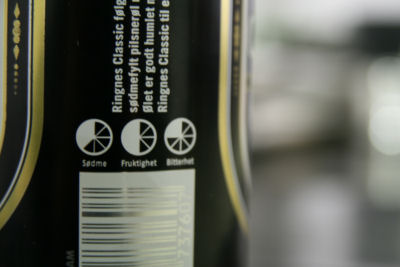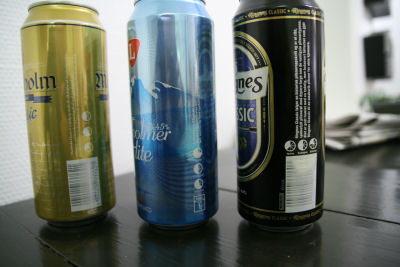Ringnes taste indicators

Ringnes Classic up close |
The biggest Norwegian brewer, Ringnes, a while ago introduced taste indicators on their beers to help consumers judge the taste of a given beer before trying it. The indicator system describes the taste in terms of sweetness, fruitiness, and bitterness, using for each a circle divided into eight sectors to show how much there is of each of these.
In principle this is a good idea, of course. Ringnes has no fewer than 56 beers on the market at the moment, and so consumers cannot be expected to be familiar with them all. Presumably the thinking at Ringnes has been that these indicators will help curious consumers considering whether to stick to a known favourite like Ringnes Pils, or to sample the delights of say, Lysholmer Lite or Ringnes Grill Pils.
But how well does it actually work in practice? Let's pick a beer at random and see. The aforementioned Lysholmer Lite is, like nearly all beers on the Norwegian market, an industrial pale lager. It's a low-carb variant (hence the "lite"), brewed as an ice beer, which reduces the taste quite considerably. The result is a beer with very little taste, but it does have some traces of apple and malts, plus a bit of metal. By no means a really bad beer, but instantly forgotten.
So, what do the indicators say? They give it 6/8 (75%) for sweetness, 4/8 (50%) for fruitiness, and 5/8 (62.5%) for bitterness. For a beer that by international standards is nearly tasteless these are quite interesting results. There are many Belgian beers that would probably merit 32/8 (400%) for sweetness on this scale, and the same goes for the other two scales. In fact, most of the beers I drink would be off the scale on all three counts, and probably all of the beers I like.
Now, there is also a textual description of the taste, and since we're diving into this so carefully and scientifically, I think I better include that as well:
Lysholmer LITE is an easy-drinking pilsener with 30% less calories and 70% less carbohydrates than normal pilsener. The taste is fresh, with little bitterness, a light sweetness, and Lysholmer's characteristic fruity taste. (Translated from Norwegian.)

Munkholm Classic, Lysholmer Lite, and Ringnes Classic |
So, according to the text this isn't a very sweet beer, but it's still given a 75% score for sweetness. This makes one wonder what they give, say, their Christmas beers, many of which really are sweet. There is also little bitterness, the text claims, although the indicators have it at 62.5%. And, finally, the text says that the one thing the beer really is, is fruity. A pity that the indicators have it at only 50% fruitiness, then. If we compare the values given for different beers we get similarly confusing results, although I won't bother going into this here.
So while taste indicators are a good idea in principle, this particular example of it has not been well executed. These indicator scales are misleading because they imply that most beers have very little sweetness, fruitiness, and bitterness. They are also misleading because they flatly contradict both the text on the cans and the tasting notes from "experts" from RateBeer.
A more successful example of such indicators comes from Nøgne Ø (later imitated by Haandbryggeriet), which uses the colour on the label to give at least a vague indication of how heavy the beer in the bottle is. The Ø on the label is white for witbier and purple for porters and stouts, with several gradations in between, and some inconsistencies. For microbrews this really is needed, because microbrews actually taste something, and some of them have quite lot of taste indeed. This system works, but is of course much less precise than the scales used by Ringnes. However, for those who want precision, final gravity and IBU are given on the labels, although most people can't interpret those.
Maybe the microbrewers should take on something like the Ringnes system, but do it right? This might help consumers who are unfamiliar with anything other than pilsener and Christmas beer, and given that that probably means most people in Norway, this might actually help sell the beers...
Similar posts
How to Understand Beer
Most people who are not into beer tend to divide beer into two types: normal and dark, and they'll tell you things like "I don't like dark beer," which makes no sense
Read | 2006-08-17 20:23
Are macro lagers really all the same?
Beer enthusiasts like to say that people who argue over which industrial pale lager is best are missing the point, because they all essentially taste the same, and none of them are very good, anyway
Read | 2011-05-08 16:23
Ringnes Imperial Polaris
For years now everyone's been wondering when Ringnes was going to wake up and realize that the old days of selling cheap industrial beers were over
Read | 2012-10-04 20:25
Comments
grove - 2008-02-14 07:37:38
I've been curious to know whether it is the black or the white coloured pies that count? By comparing the Lysholmer Lite with the Ringnes Classic I would guess it is the black ones. :)
Erik - 2008-02-22 02:03:32
Good point Lars, I believe this indicator is just another part of the conspiracy from the mainstream beer producers. They are simply denying for the existence of good flavorful beers. I also think this indicator where adapted from Carlsberg when they bought Ringnes. As far as I remember, this indicator isnít even in use at Carlsberg own quality labels Jacobsen and Semper Ardens. This indicator is only meant to be used for the brainwashed.